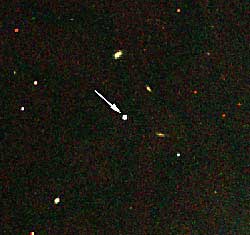
The fading afterglow of the March 29th gamma-ray burst, seen 2.6 days later by the 1.3-meter telescope at the Cerro Tololo Inter-American Observatory in Chile. By then the afterglow had faded to 17th magnitude — still bright enough to hide any trace of its underlying host galaxy.
Courtesy Joshua Bloom (Harvard/CfA), Michelle Buxton, Pieter van Dokkum (Yale), and the SMARTS Consortium.
If you live in western North America and were watching the constellation Leo early on the morning of March 29th, you just might have been able to see a titanic explosion 2 billion light-years away — with your naked eyes.
At 11:37 Universal Time (3:37 a.m. PST), the afterglow of a powerful gamma-ray burst on the back of the Lion may have brightened to something like 5th magnitude. GRB 030329, named for the date it happened, ranks as the nearest and probably the optically brightest classical gamma-ray burst ever observed.
The burst was first detected by the suite of gamma- and X-ray detectors on board NASA’s High Energy Transient Explorer 2 (HETE-2). Described by the HETE team as a "monster GRB," it lasted some 50 seconds and briefly emitted more energy toward us than everything else in the universe combined. HETE fixed its position and sent an alert to a worldwide network of astronomers within seconds. Working around clouds and thunderstorms, Bruce A. Peterson and Paul A. Price (Australian National University) detected the rapidly fading visible-light afterglow less than 90 minutes after the burst, when it still shone at 12th magnitude.
Spectra taken at the European Southern Observatory’s Very Large Telescope in Chile soon pinned down the afterglow's redshift as 0.1685. This means GRB 030329 is 2 billion light-years away, compared to the 5 to 10 billion or more light-years for run-of-the-mill GRBs. It is the closest-ever burst with a known redshift (other than the odd, weak, atypical burst associated with the strange supernova 1998bw).
The optical afterglow was even recorded by many amateur astronomers, such as the Nyrölä Observatory team in Finland, using telescopes as small as 12 inches. The X-ray and radio afterglows of the monster burst were also extremely bright. Surprisingly, however, archival images of the burst location don’t show any object brighter than 22nd magnitude, indicating that the host galaxy of the titanic explosion is intrinsically very faint. Deep searches for the host galaxy will have to wait until the afterglow has dimmed sufficiently.
A new mystery soon surfaced. Astronomers watched as the diminishing afterglow temporarily rebrightened several times, about 30, 60, and 80 hours after the burst. Other gamma-ray bursts have displayed single rebrightenings or pauses in fading, perhaps due to an underlying supernova, but the light curve of GRB 030329 is more complex. Nor has the afterglow changed color as one would expect of a supernova. According to Weidong Li (University of California at Berkeley), "Density inhomogeneities [among surrounding gas clouds] and extra energy sources are possible explanations" for the rebrightenings.
GRB 030329 is entering the records as one of the most exceptional and best-studied gamma-ray bursts ever. Says HETE-2 principal investigator George Ricker (MIT), "With scores of observations now completed and more on the way, we should get a rather clear picture of what triggered this burst."
 0
0
Comments
You must be logged in to post a comment.